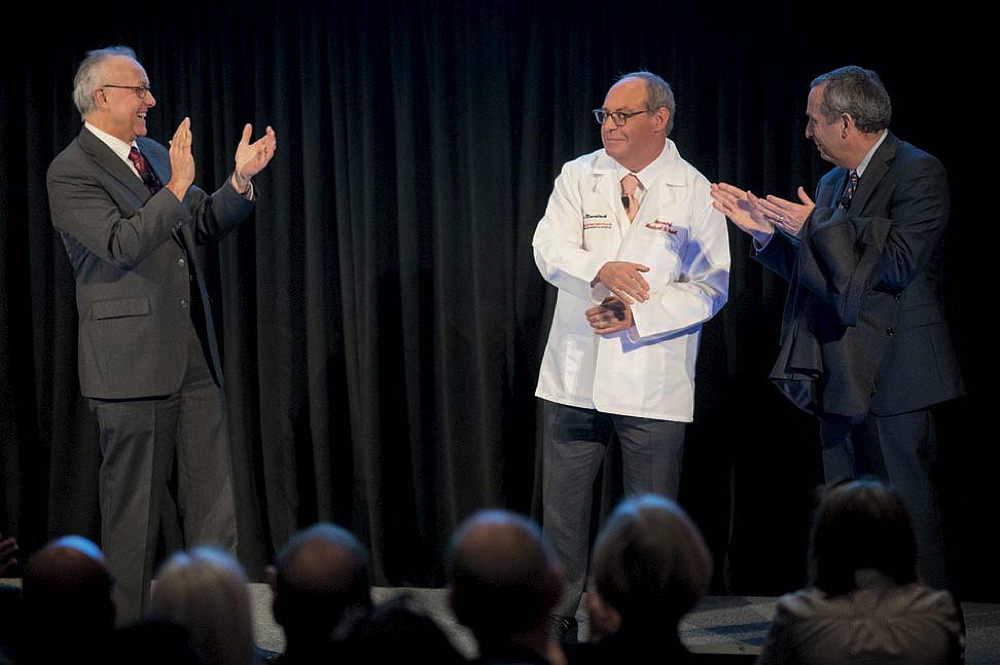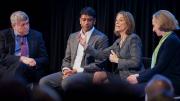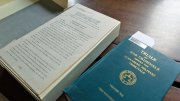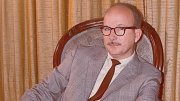Netflix has thrived in part because it knows what movies subscribers have watched—and which films similar viewers have enjoyed. Is there an analogy to this powerful recommendation protocol applicable to medicine? Nelson professor of biomedical informatics Isaac Kohane thinks so. During a Harvard Medical School (HMS) symposium on November 8, he outlined a tool that would encourage cancer “superresponders”—the patients who achieve gains in longevity not of a year or two, but of many times that—to share their health and therapeutic histories, genomic data, lifestyle indicators, and more, so clinicians will know what drugs to try when they meet new but similar patients. Harnessing such patient data with therapeutic information and possible clues to further research, he said, would radically advance cancer treatment, making current miracle cures the standard of care by 2030.
That vision may now have a better chance of becoming reality. The symposium celebrated a $200-million gift, the largest in HMS history, focused on four priorities:
• investments in the infrastructure and technology for basic and clinically applicable research;
• faculty appointments focusing on biomedical informatics (see “Toward Precision Medicine,” May-June 2015, page 17) and data science, among other fields;
• grants to seed collaborations among HMS researchers and those at its 15 affiliated hospitals and other research institutions—an important step toward harnessing the latent power of the Greater Boston biomedical ecosystem; and
• a Longwood Medical Area “life lab,” a counterpart to the facility in Allston, to support nascent biotechnology and life-sciences enterprises.
The gift, from the Blavatnik Family Foundation, builds upon prior support for biomedical research from Len Blavatnik, M.B.A. ’89, who has been a benefactor of science around the globe. A $10-million gift to Harvard in 2009 split evenly between cancer-vaccine research and a “biomedical accelerator fund,” to encourage development of ideas with commercial potential, was followed by a $50-million gift, in 2013, in support of translating basic science into therapies and a Harvard Business School fellowship program for life-sciences entrepreneurs. Those were mere preludes to the newest philanthropy, summarized in the news announcement this way:
School priorities supported by the gift include deepening fundamental discovery; accelerating the development of new treatments; spurring applications of data science toward the comprehension, diagnosis, treatment and cure of disease; recruiting data scientists, computational biologists, bioengineers and other experts; and catalyzing collaborative discovery across the broader Harvard life sciences ecosystem.
The presentations by Kohane and others illustrated some of the scientific and therapeutic potential. A separate panel discussion, moderated by MIT president emerita Susan Hockfield, a neuroscientist, demonstrated some of the leverage from bringing the expertise resident in Boston-area institutions—with their thousands of basic researchers, academic clinicians, and skilled technicians—to bear on common problems. Laurie Glimcher ’72, M.D. ’76, president and CEO of Dana-Farber Cancer Institute, and professor of systems biology Eric Lander, the president and founding director of the Broad Institute of MIT and Harvard (a leading center for genomics research), said it mattered not at all whether scientists conducted research at one venue or another. Both hailed the growth of an intellectually integrated “community” of life scientists. Glimcher also cited the collaborations among academic medical centers and pharmaceutical companies as “a marriage made in heaven,” noting the relationship dating to 1982 between her enterprise and Novartis, which has a vast research center in Cambridge. Novartis CEO Vasant Narasimhan, M.D.-M.P.P. ’03, cited the advantages of scale in bringing discoveries to patients’ bedside: his company performs 550 clinical trials per year, he said, and its compounds treat a billion people annually (the sort of data that, ultimately, Kohane and his bioinformatics colleagues hope to harness).

With Len Blavatnik ironically laid low in London following surgery, Dean George Daley (left) and President Larry Bacow conferred an HMS jacket on his brother, Alex Blavatnik—a sign of membership in the Medical School community.
Photograph by Kris Snibbe/Harvard Public Affairs and Communications
President Lawrence S. Bacow hailed the gift as an endorsement of “curiosity-based research” and a powerful statement of support for the “unique ecosystem” of life and biomedical sciences in Greater Boston, where “We have the capacity” to transform health and reimagine health care. He thanked Blavatnik for “supporting the very best people in the very best places,” especially in the life sciences, raising the odds for discoveries of fundamental importance.
An ebullient HMS dean George Q. Daley proclaimed this a “pivotal moment in the history of medicine,” and said the new gift would have a “transformative impact and outcomes.” Stressing the importance of collaborating with community institutions and scientists, he said it was “not a gift just to Harvard but to biomedicine through Harvard,” igniting a “new era of discovery.”
The gift, which has been in the works since earlier in the year, underscores a fundamental strengthening of HMS, which has been operating at a deficit for several years (not unusual among institutions which conduct expensive “wet” lab science; the fiscal year 2018 red ink was $39 million). It follows the school’s successful capital campaign, which realized $789.4 million in gifts and pledges (much of that for research, as was noted in a November 8 evening celebration at Fenway Park), and the recent sale of a leasehold interest on an HMS research building (which brought in another $272.5 million).
In a hard-to-believe moment, the donor himself was absent from the gala celebration of his stupendous gift: a resident of London, Len Blavatnik was recuperating in a hospital there following an appendectomy, occasioning some rueful humor about expedient medical care; he watched the proceedings by a live video link. For a detailed report on the Blavatnik gift and HMS, see harvardmag.com/hms200mgift-18.
Separately, Harvard’s science aspirations were advanced by another nine-figure gift, this one to the Faculty of Arts and Sciences (FAS). On October 12, The Harvard Gazette unveiled an anonymous $100-million gift, by an alumnus and his wife, designated to keep the Science Center in shape as a core undergraduate teaching facility; support mathematics research; and provide unrestricted funding for use at the discretion of the FAS dean. The donor is described as a 1990s College graduate; his interests, in collaborations with Israel and in mathematical finance, perhaps provide grist for budding applied mathematicians to develop an algorithm to try to peel back the cloak of anonymity from one of the most generous donors in Harvard history.









